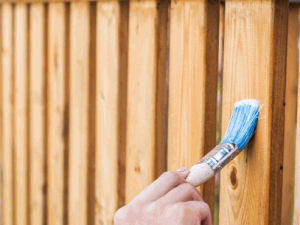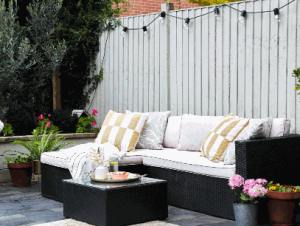
Can Fence Paint Be Used On Garden Furniture
- Furniture
- December 19, 2023
Are you tired of constantly replacing your garden furniture because of wear and tear? Do you want to find a cost-effective and efficient way to protect and revitalize your furniture? Look no further! In this article, we will explore the possibility of using fence paint on your garden furniture and how it can be a game-changer for your outdoor space.
Can Fence Paint Be Used On Garden Furniture?
Contents
Yes, fence paint can indeed be used on garden furniture. This type of paint offers a durable and weather-resistant finish, making it perfect for outdoor furniture. However, it is important to make sure that the paint is specifically designed for exterior use and is safe for surfaces that may come into contact with skin, such as garden chairs and tables. It is also recommended to use a primer before painting to improve adhesion and longevity.
When selecting a color, choose shades that complement your garden’s aesthetic and blend seamlessly with the surroundings.

What Is Fence Paint?
Fence paint is a specialized type of paint that is made specifically for outdoor wooden fences. Its purpose is to shield the wood from damage caused by weather and decay, resulting in a strong and long-lasting coating.
When selecting a fence paint, it is important to take into account factors such as resistance to weather, color retention, and ease of application. Popular brands of fence paint include Cuprinol, Ronseal, and Behr. It is crucial to confirm that the chosen paint is suitable for the particular type of wood and outdoor environment.
Check out: What Fence For Landscaping

What Are The Different Types Of Fence Paint?
The various types of fence paint available include:
- Acrylic Paint – is known for its durability and ability to withstand harsh weather conditions.

- Oil-based Paint – offers superior adhesion and protection.

- Water-based Paint – a more environmentally friendly option that is also easy to clean.

Each type of fence paint caters to specific needs, providing a range of choices based on factors such as material, weather conditions, and desired finish.
In fact, the durability of acrylic fence paint has made it a popular choice for outdoor furniture, ensuring long-lasting protection and a wide range of vibrant color options.
What Types Of Garden Furniture Can Be Painted With Fence Paint?
Fence paint can be used on a variety of garden furniture, including wooden benches, tables, chairs, and Adirondack chairs. Its durable finish is able to withstand outdoor conditions, making it a suitable choice for different types of furniture.
Fact: When applied correctly, fence paint can provide long-lasting protection for garden furniture, helping to preserve it for many years to come.
Can Wooden Garden Furniture Be Painted With Fence Paint?
Yes, it is possible to paint wooden garden furniture with fence paint. However, before doing so, make sure that the wood is clean, dry, and does not have any previous finishes. Choose a high-quality fence paint that is specifically designed for exterior use and provides weather protection and durability. Apply the paint evenly, following the natural grain of the wood, and consider using a primer to improve adhesion.

Can Metal Garden Furniture Be Painted With Fence Paint?
Yes, metal garden furniture can be painted with fence paint. To ensure proper adhesion and durability, it is recommended to use a high-quality outdoor metal paint or a specific metal primer. Before applying the paint, prepare the metal surface by cleaning and sanding it. For best results, apply multiple thin coats for even coverage and long-lasting durability.

Can Plastic Garden Furniture Be Painted With Fence Paint?
Yes, it is possible to paint plastic garden furniture with fence paint. However, proper preparation is key. Before applying the paint, make sure to use a plastic primer and ensure that the furniture is clean and dry. It is important to choose a high-quality fence paint that is suitable for plastic surfaces. Apply thin, even coats of paint, allowing each coat to dry thoroughly. For added protection against weather and wear, finish with a clear sealant.

What Are The Benefits Of Using Fence Paint On Garden Furniture?
When it comes to protecting and enhancing the appearance of your garden furniture, using fence paint may not be the first thing that comes to mind. However, this versatile and cost-effective option can offer several benefits when applied to your outdoor furniture. In this section, we will discuss the advantages of using fence paint on garden furniture, including its ability to provide protection against harsh weather conditions, its wide range of color options, and its affordability compared to other types of paint.
1. Protection Against Weather
- Prepare the furniture by cleaning and sanding to ensure a smooth surface for paint adhesion.
- Choose a high-quality fence paint that provides protection against weather, such as waterproof and UV-resistant options.
- Apply the paint evenly, using a brush or sprayer, following the manufacturer’s instructions.
- Allow the first coat to dry completely before applying a second coat for enhanced durability.
- Maintain the painted furniture by reapplying the paint as needed to sustain protection against weather.
2. Versatility In Colors
When using fence paint on garden furniture, the array of colors available offers a wide range of options to match your outdoor aesthetic. Some fence paints come in various shades, giving you the flexibility to personalize your garden furniture and complement your overall decor scheme.
3. Cost-effective Option
- Choosing fence paint as a color option for garden furniture is a cost-effective choice compared to using specialized furniture paint.
- It provides a budget-friendly alternative for revitalizing worn-out pieces.
- Using fence paint allows you to give your garden furniture a fresh appearance without spending a lot of money.

What Are The Risks Of Using Fence Paint On Garden Furniture?
While fence paint may seem like a versatile option for sprucing up your garden furniture, there are some important considerations to keep in mind. In this section, we will discuss the potential risks of using fence paint on your garden furniture. From potential adherence issues with certain materials to limitations in high-traffic areas, we will explore the possible drawbacks of using fence paint for this purpose. So, before reaching for that paintbrush, let’s delve into the potential risks and see if it’s the right choice for your garden furniture.
1. May Not Adhere Well To Certain Materials
- To promote adhesion, make sure the surface is clean and dry.
- Use a primer or undercoat specifically designed for the material to ensure proper adhesion.
- When choosing a paint, consider the material of the furniture – wood, metal, or plastic – and select a formula specifically formulated for that material.
- Before applying the paint fully, it is recommended to first apply a test patch to assess adhesion.
2. May Not Be Suitable For High-Traffic Areas
- High-Traffic Areas: Fence paint may not be suitable for heavy use on garden furniture.

How To Paint Garden Furniture With Fence Paint?
Painting garden furniture can be a daunting task, but it doesn’t have to be. In fact, you may already have the perfect paint for the job – fence paint. In this section, we will discuss how you can use fence paint to give your garden furniture a fresh new look. From preparing the furniture to choosing the right type of fence paint, we will cover all the necessary steps for a successful painting project. So, let’s get started on transforming your outdoor space with just a few simple steps.
1. Prepare The Furniture
- Clean the furniture: Remove any dirt, dust, or debris from the surface using a brush or a damp cloth.
- Sand the furniture: Smooth any rough areas or old paint using sandpaper to create a suitable surface for the new paint to adhere to.
- Repair any damage: Fill in any cracks or holes with wood filler for wooden furniture or suitable filler for other materials.
2. Choose The Right Type Of Fence Paint
- Consider the Material: For wood furniture, use a stain or a wood-specific paint. For metal, opt for a rust-resistant enamel paint. Plastic furniture requires a primer and paint specifically formulated for plastic.
- Weather Resistance: Choose a paint that offers protection against UV rays, moisture, and temperature changes to ensure durability.
- Color Options: Select a paint that provides a wide range of colors to match your outdoor decor and personal preferences.
- Longevity: Look for a paint with a proven track record of maintaining its color and finish over time, ensuring the longevity of your furniture.
When selecting the right type of fence paint, it’s important to consider the specific requirements of your garden furniture. Choose a paint that is suitable for the material, offers weather resistance, provides a variety of color options, and ensures longevity.
3. Apply The Paint
- Prepare the surface by cleaning and sanding the furniture to ensure the paint adheres well.
- Choose a high-quality fence paint suitable for the material of your garden furniture.
- Apply the paint evenly using a brush or sprayer, following the manufacturer’s instructions.
- Allow the first coat to dry completely before applying a second coat for better coverage and durability.
- Maintain the painted furniture regularly and reapply the paint as needed to preserve its appearance and protection.

4. Allow The Paint To Dry
- After applying the first coat of fence paint on the garden furniture, allow it to dry completely. Follow the manufacturer’s instructions for the recommended drying time.
- Ensure that the weather conditions are conducive for drying, avoiding high humidity or rainy days, which can prolong the drying process.
- Inspect the furniture to confirm that the paint has thoroughly dried before applying the second coat.
For best results, consider placing the furniture in a well-ventilated area to expedite the drying process. Additionally, gently touch the painted surface to check for tackiness before proceeding with the next coat.
5. Apply A Second Coat
- Carefully inspect the first coat for any missed spots or uneven coverage.
- If necessary, lightly sand any rough areas or imperfections.
- Clean the surface to remove any dust or debris.
- Apply the second coat of fence paint using smooth and even strokes.
- Allow the furniture to dry completely before using or applying any additional coats.
6. Maintain And Reapply As Needed
- Regular Cleaning: Wipe the furniture with a damp cloth to remove dust and dirt.
- Observation: Check for any signs of wear or fading of the paint.
- Reapplication: If the paint shows signs of wear, reapply a fresh coat of fence paint to maintain protection and aesthetic appeal.
- Maintain and Reapply as Needed: Make sure to regularly maintain and reapply paint as needed to keep your furniture looking its best.





